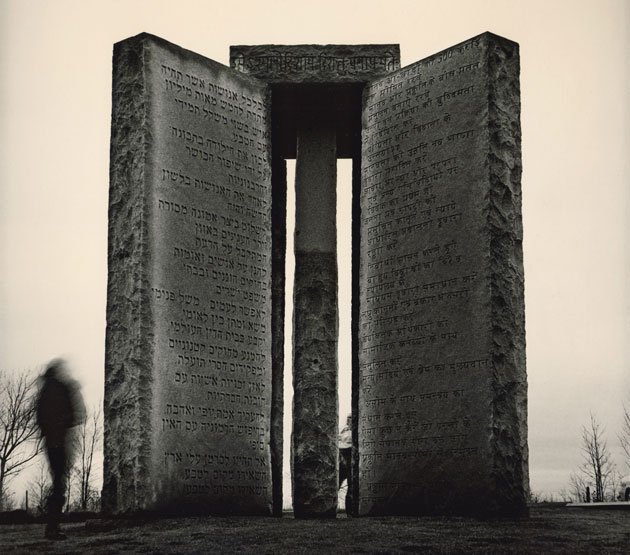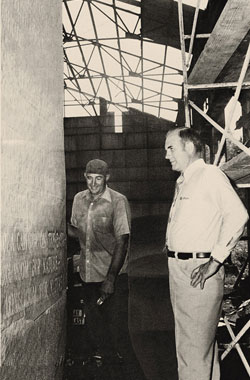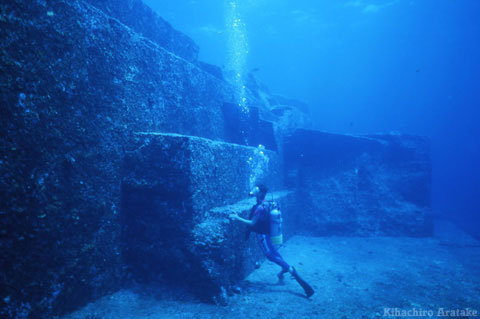1. Monumental Instructions for the Post-Apocalypse / The Georgia Guidestones, United States
On a small hill in the arid northeast region Hartwell, Georgia USA, stands the most bizarre and mysterious monuments in the world. But look at the architecture of the building, the monument was not invented in ancient times.
Known as the "Georgia Guidestones", the five stones structure has 16 feet high, weighing 20 tons.
Has four rectangular granite stone pillars that lead upwards, each pillars has the carved instructions and directions of the eighth "greatest cultural language" such as, Arabic, Cina, Russia, Inggris, Spanyol, Hindi, Hebrew and Swahili - with instructions for the human survivors of major disasters can rebuild a new civilization on this earth and not at all leave and forget the history of the ancestors.
The four pillars shaped like a plus sign and has a range of about 5 meters hence in the middle of them there is a central pillar which written Commandments on it, and then on the top of them there is a rectangular shaped granite stone.
On the four sides of the granite stone that was lying, there are intructions with the "language of the old culture" that has been lost from the world. And these languages are Sanskrit language, Ancient Greek (Classical Greek) and Babylonian Cuneiform and Ancient Egypt (symbolic) or Egyptian Hieroglyphic.
Are the instructions in eight languages associated with doomsday predictions? It is still a mystery.
The building was founded by a group of Masonic, Freemasons, Illuminati, the pagans and the supporters of other satanic groups. Read this
Looks they have made this site but on the top of the highest in the flat field are the epitome of their group.
So as if all the world and across cultures is derived, and the subject came from a single source, namely those group who want to set up a New World Order.
Proven they intend to teach this ideology, and will continue in subsequent human culture.
 This command is also not clear to whom addressed. More is not clear yet, who built this strange monument? There is only one person who knows but he does not want to talk.
This command is also not clear to whom addressed. More is not clear yet, who built this strange monument? There is only one person who knows but he does not want to talk.2. Lake Michigan Stonehenge, United States
At first, a group of researchers using sonar to look for shipwrecks at the bottom of Lake Michigan, the results are quite surprising. They instead found the ancient Stonehenge-like structure 40 feet beneath the surface of the water near the Beaver Island. Most of the stones in a circle and one appears to show carvings of a Mastodon.
Most of the stones in a circle and one appears to show carvings of a Mastodon.Allegedly, these ancient objects was built 10,000 years ago, possibly coinciding with the post-Ice Age presence of humans and Mastodons.
So in the area of Michigan in the United States already has petroglyph sites and standing stones.
3. Yonaguni, Underwater Civilization Ruins, Japan
On the south coast of the island of Yonaguni, Japan, there are submerged ruins, thought to have been around 8,000 years old.
This underwater ruins is also known as Yonaguni Monument Underwater Ruins.
"Though some people believed that it was carved by geographic phenomena, it’s now confirmed to be man-made as the intricate stairways, carvings and right angles suggest."Although most people believe that it is a creation of nature, but it now appears the voices who call it man-made.
The flat parallel faces, sharp edges, and mostly right angles of the formation have led many people, including many of the underwater photographers and divers that have visited the site and some scholars, to the opinion that those features are man-made.
These people include Gary and Cecilia Hagland and Tom Holden who went on underwater expeditions to study and photograph the site as well as Dr. Sean Kingsley, a marine archaeologist. These features include a trench that has two internal 90° angles as well as the twin megaliths that appear to have been placed there. These megaliths have straight edges and square corners. However sea currents have been known to move large rocks on a regular basis.
Some of those who see the formations as being largely natural claim that they may have been modified by human hands. The semi-regular terraces of the Monument have been compared to other examples of megalithic architecture, such as the rock-hewn terraces seen at Sacsayhuaman. The formations have also been compared to the Okinawa Tomb, a rock-hewn structure of uncertain age.
Other evidence presented by those who favor an artificial origin include the two round holes (about 2 feet wide, according to photographs) on the edge of the Triangle Pool feature, and a straight row of smaller holes which have been interpreted as an abandoned attempt to split off a section of the rock by means of wedges, as in ancient quarries. Kimura believes that he has identified traces of drawings of animals and people engraved on the rocks, including a horse-like sign that he believes resembles a character from the Kaida script. Some have also interpreted a formation on the side of one of the monuments as a crude moai-like "face".
Supporters of artificial origin also argue that, while many of the features seen at Yonaguni are also seen in natural sandstone formations throughout the world, the concentration of so many peculiar formations in such a small area is highly unlikely. They also point to the relative absence of loose blocks on the flat areas of the formation, which would be expected if they were formed solely by natural erosion and fracturing.
If any part of the Monument was deliberately constructed or modified, that must have happened during the last Ice Age, when the sea level was much lower than it is today (e.g. 39 m (130 ft) lower around 10,000 years BCE).
During the Ice Age, the East China Sea was a narrow bay opening to the ocean at today's Tokara Gap. The Sea of Japan was an inland sea and there was no Yellow Sea; people and animals could walk into the Ryukyu peninsula from the continent. Therefore, Yonaguni was the southern end of a land bridge that connected it to Taiwan, Ryuyu, Japan and Asia. This fact is underscored by a rock pillar in a now-submerged cave that has been interpreted as a fused stalactite-stalagmite pair, which could only form above water.
Kimura first estimated that this must be at least 10,000 years old (8,000 BCE) dating it to a time when it would have been above water.
In a report given to the 21st Pacific Science Congress in 2007 he revised this estimate and dated it to 2,000 to 3,000 years ago as the sea level then was close to current levels.
The existence of an ancient stoneworking tradition at Yonaguni and other Ryukyu islands is demonstrated by some old tombs and several stone vessels of uncertain age.
This is evident from the composition of complex stairs, carvings which there are believed to be man-made.
This site was found in 1995 by a diver who strayed too far from the coast of Okinawa. Incidentally he also brought cameras to take pictures underwater.
4. Alexandria, Egypt
These ruins are believed to be the city of Alexander the Great, where Cleopatra's palace is located. The sinking of the city was estimated to occur 1,500 years ago due to a devastating earthquake.Along with the castle sinking, sinking also artifacts that adorn the palace, and other buildings of Cleopatra's palace.
City ruins discovered in the seabed, was deliberately not appointed to the mainland.
The local government plans to make the location of the ruins of magic under the sea as water attractions.
part-2 | part-3 | part-4 | part-5
5. Mystery of Baalbek Stones, Lebanon
The largest Roman temples ever built and now only ruins, in fact, its not in Greece or Rome, but rather in Baalbek, Lebanon.
Roman Temple named Baalbek Stone was destroyed by the Byzantine Emperor Theodosius, lucky not all parts destroyed.
There are still 6 of 54 columns, which still stands today.
Six columns here to witness history and leaving a trail of mysteries that await revealed.
Although the remains of the splendor of this temple still visible, but indeed, the temple was abandoned due to the war.
For decades, travelers rarely visit this place due to the war. Fortunately, too, the war is not to destroy this historic temple.
Roman Temple named Baalbek Stone was destroyed by the Byzantine Emperor Theodosius, lucky not all parts destroyed.
There are still 6 of 54 columns, which still stands today.
Six columns here to witness history and leaving a trail of mysteries that await revealed.
Although the remains of the splendor of this temple still visible, but indeed, the temple was abandoned due to the war.
For decades, travelers rarely visit this place due to the war. Fortunately, too, the war is not to destroy this historic temple.










0 comments:
Post a Comment